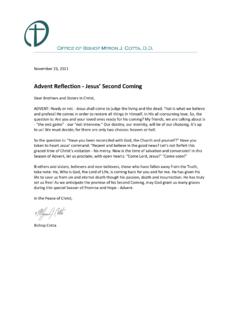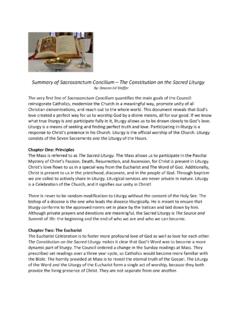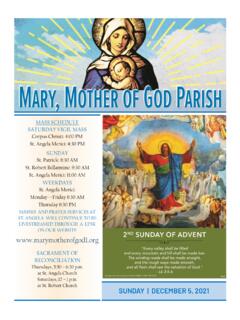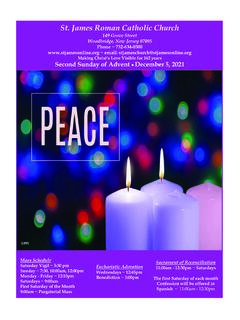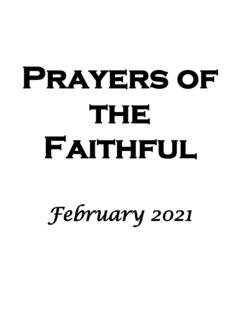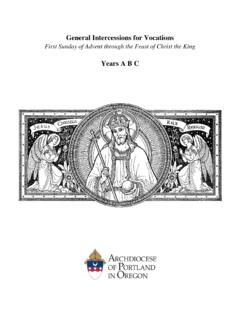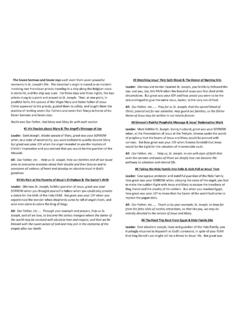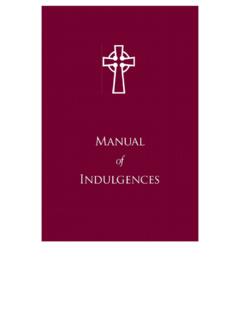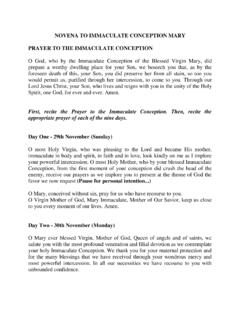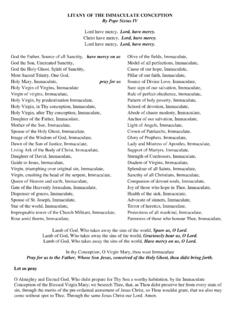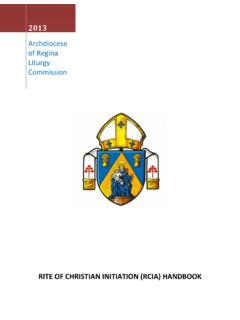Transcription of Guidelines - Music Within the Mass
1 Guidelines : Music Within the Mass Introduction The purpose of these guid elines is to pro vide su pport to parish Music leaders and gr oups in their d ay-to- day minis try of mu sic Within the Ma ss. The do cument recalls the centra li ty of the Eucharist to o ur Catho lic way of lif e, helps in understanding the purp ose and importance of Music wit hin the Ma ss, ident ifies t he as semb ly as the p rima ry mu sic mi nister, details the important role of mu sic mi nisters in pr eparation and coor dination of the as sem bly s mus ic m inistry, ident ifies t he di ffe rent fo rms of l iturg ical so ng with in t he Ma ss, expl ains the options a nd helps guide the selection of Music for the va rio us parts o f the Mass, ident ifies o ther key c oncer ns for par ish and s cho ol m usic mi nistry as we ll as strat egies and re sou rces to add ress the m.
2 It is ho ped that these guid elin es will assi st you in your Music mi nist ry and help make our cele bration of the Ma ss an uplifting ex perien ce of the community at pray er and w orship. The Centrality of Liturgy and the Eucharist As Ca tholics, we know that cele brating the litu rgy of the Chu rch is at the h eart of the way we give glory to Go d. The term liturgy h as its origins in the G reek word , meaning p ublic work' or a ' servi ce in the na me of / on behalf of the peopl e.' This wo rd appears th roughout the New Te stame nt, a nd is und ersto od to mean the participation of the People of God in the work of the Triu ne Go d ( cf. Lk 1: 23; Acts 13:2; Rom 15:16, 2 7; 2 Cor 9:12; Ph il 2:14-17, 2 5, 3 0; Heb 8:2, 6). Through liturgy, Christ con tinues the w ork of our r edemption in, with and t hrough his Church.
3 The li turgy is our w ay of parti cipa ting pub licly in the on going work of Christ in wors hi p, p rocla mat io n of the G osp el and a ctive cha rity to the glo ry of G od (Catec hism of the Catholic Church (CCC), 1069 -70). No wonder the Second Vat ican C ouncil described liturgy as the su mmit and sou rce of the Ch urch s activity (C ons titution on Sacr ed L iturgy, Sacrosanctum Co ncili um, 1 0), a nd Eucharist ( the Ma ss) as the sou rce and summit of Chris tian life ( Dog ma tic Consti tution on the Church, Lumen Gentium, 11). The Function and Importance of Music in Liturgy Our m odel for Music in the li tur gy is Jes us him self, w ho sang psalms with the apos tles a t the La st Supper (Mt 26:30; Mk 14:26). Music is an integral part of our pa rticipation in liturgy an inte gral part of our participation in the work of Go d.
4 For wh en song and mus ic are sig ns of the Holy Sp irit s pre sence and a ction, they encourage, in a certain way, com munion with the Trinity (John Paul II, Address to the Pontific al Instit ute of Sacr ed Mu sic, 3; Chi rograph on Sacr ed Mu sic, 3). The Se cond Vatican Council s C onstitution on S acred Litu rgy (C SL) ma de particular mention of the role of Music in fulfi lling the purp ose of l itur gy, which is the glory of God and the sa nct ific ation of the faithful (C SL 11 2). The Second Vatican Coun cil s In stru ction on Music in the L itur gy, Musicam Sacram (M S), ment ions f ive spe cific minist erial func tions of Music in the l itur gy. Through mus ic in the li turgy: 1. prayer is g iven a m ore gra cef ul expr ession, 2. the m ystery of the liturgy, with its hierarchical and community nature, is more openly s ho wn, 3.
5 The unity of hearts is more profoundly achieved by the union of voices, 4. minds are more easily raised to heavenly things by the beauty of the liturgy, and 5. the who le cele bration more cle arly pre fig ures the he avenly lit urgy (cf. MS 4- 5). One cann ot find anything more religio us and mo re joyful in sacred cele bra tions than a whole con gregation expr essing its faith a nd de voti on in song (MS 16). Great importance sh ould theref ore be atta ched to the use of singing in the celebr ation of the M ass, with due consi deratio n for the culture of p eopl es and abil iti es of each li turgical ass emb ly. Although it is not always nec essary ( , in wee kday Ma sse s) to s ing a ll t he texts that are in pri nciple m eant to be sung, every care should be taken that singing by the m inisters and the people is not abse nt in celebrations that occ ur on Sundays a nd on holy days of o bli gation (Ge ner al In stru ction of the R oman Missal (GIRM ), 40).
6 Our preparation and leadership of mu sic w ithin the Mass greatly assists the People o f God, the community as the b ody of Christ, to experi ence "n ew life in the Spirit, involveme nt in the mission of the Churc h, and service to her u nity" (CCC 1072). The Role of the Music ministry The pri ma ry Music mi nist er in the li turgy is the a ssem bly. At certain times the priest, the deacon, the choir, the musicians, the psalmist and t he cantor have speci fic ro les of their own. But there is no place in the li turgy for perfo rmances of a rt for art s sake. Of special importance are the ro les of Music director, choir director and Music coordinator, who are respo nsible for p rep aring, rehearsing and conducting the mu sical aspe cts of liturg ical celebr atio ns . They ha ve a vit al role in ch oosing the mu sic and he lping the ass embly take an active part in the si nging (cf.)
7 CSL 28, 30, 114, 118, and 121). The role of vo ice traine rs is cri tical in prepa ring psalmists to s ing the respo nsori al p salm. From the smo oth co ordination of a ll the pri est cele brant and the deacon, the a colytes, the altar servers, the read ers, the psalmist, the schola cantorum (ch oir), the musicians, the cantor and the assem bly flows the p roper spiritual atmosphere which makes the litur gical moment tr uly inte nse, shared in and fruitful (Chirograph, 8). Liturgical Song Forms Liturgical song is Music wed to prayer tex t. The litur gy comprises a variety of differe nt forms of prayer, each requiring a d ifferent song form for musical e xpr ession. Each part o f the Mass takes one of the following sev en forms: A An accl amation is a s pont aneous joyful v oca lisation sung by a ll, acc ompanied or unaccompanied.
8 C a cantillation is a kind of spoken sing ing, usua lly una ccom panied, wh ere the melody and rh ythm is close to that of speech. It is used wh en pra yers, readings and pro clama ti ons a re su ng in stead of re cit ed. Canti llatio ns are s un g by the priest ce lebrant or other m inis ter and con clu de with an acclamation of a ssent sung by all. D A dialogue betw een priest and people is us ed at the start of the Ma ss, and to introd uce each maj or part the Gospel, the Eucharistic Prayer, the C ommunion, a nd the dis mis sal. Dialog ues are sung u nacc omp anied. H A hymn is a song of praise with no other accompanying liturgical a ction. There are only two h ymns in the Mass, and they are not always sung. Singing of the Gl ory to God is by the choir or cantor a lterna ting w ith the people, or entirely by the pe ople or entirely by the choir alo ne ( GI RM 53).
9 If there is a so ng of pr aise after communio n, sin ging is b y the entire ass embly (GIRM 88). L A litany is a pray er with a series of in vocations or inte rce ssions sung by a can tor or other minister, w ith a repe ated response sung by a ll. P A proce ssional song is one that acc ompani es a nother lit urgic al a ction. Songs with refra ins and a vari able number of verses a re mo st ap propriate. The beginning and en ding should ma tch the lit urgic al a cti on. Singi ng is by the choir or cantor a lterna ting w ith t he people, or entir ely by the peopl e, or by the choir alone; alternatively, an instrumental solo may be played in stead of singing a s ong (GIR M 48, 74, 87 , 31 3; MS, 3 6, 66-6 7). R The responsorial psalm is sung scr ipture with no other accompanying li turgical action. All sing the psalm respo nse at the beginning and after e ach verse; the cantor of the p salm sin gs the intervening vers es.
10 The texts are pre scribed, with o ptions to u se the given psal m of the day or one of the comm on seasonal psalms or antip hons in the lec tiona ry, or a ch ant from the Graduale Romanum or the Graduale Simplex (GI RM 61) Choosing Music for Mass Mus ic fulfills i ts role in lit urgy wh en: ( 1) the amount of singing ap tly co rres ponds to th e sol emni ty of the o cca sion, ( 2) t he se lected Music pr ovid es for the unan imous participation of the a ssembly at the desi gnated moments, and (3) the b eauty of th e compositions and their performance is expressive of prayer (cf. CCC 1157). The amo unt of singing sho uld corre spo nd to the de gree of fe stivity and sol emnity of th e particular celebration of the day, feast or season (MS 7). For example, weekd ays are more sub dued than Sundays; the maj or Sunday com munity Ma ss is mo re fes tive tha n other Sund ay Masses; maj or fe asts su ch as Tr inity Sunday or Pentecost are more festive than other Sund ays; the seasons of Le nt a nd Ad vent are m ore subdued; the seasons of Christmas and Easter are more festive.
